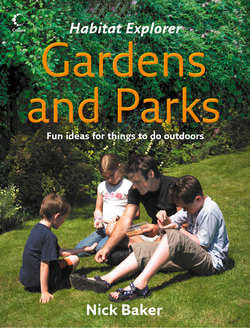Читать книгу Gardens and Parks - Nick Baker - Страница 6
Handy stuff for exploring with
ОглавлениеWhat kit you will need to explore your garden or park with very much depends on what your patch is like. If you have a little back yard in the city with hardly enough space to swing a net, you will explore it differently to someone who has a mountain in theirs. Having said this, there is interest to be found in any garden from an estate to a window box, and so here are a few bits of kit that I would find useful when exploring.
Binoculars These are always very useful, especially if you want to watch the details of the lives of birds and other insects without disturbing them. A pair of binoculars may be quite expensive to buy, but they are invaluable to a serious naturalist.
Magnifying glass/pocket microscope Most things you can make or improvise with, but a hand lens is an essential bit of kit. It needn’t be expensive and you can pick one up for pocket money. If you want to turn greenfly into monsters, though, you may need a pocket microscope. This is a bit more expensive, but worth every penny and still a fraction of the price of a Playstation!
Notebook and pen/pencil Another one of those naturalist’s staples, it’s always good to make notes, keep diaries and draw the things you notice. It is something all the great naturalists from Darwin to Bill Oddie have done. It is surprising just how much and quickly we forget details.
Plastic pots and jars These are a staple of any naturalist anywhere; handy for storing specimens, rearing insects or simply holding onto something while you inspect it with a magnifying glass. Plastic bags can do a similar job and you can keep a handful in your pocket at any time. They are useful for storing botanical plants and, if you blow them up and tie the tops with string, you can make temporary containers from them.
Sieves You may be surprised, but meshed scooping devices from sieves to tea strainers can make very handy little catching devices! They can be used like a net in water or modified into a pair of bug-catching tongs. Use larger sieves to sift through soil to find small creatures and moth pupae.
Trowel I find this handy for investigating the soil, exhuming worms and, of course, for re-digging any footprints you might leave on your parents’ flower beds. It’s always a good idea not to upset those garden proud grown-ups.
Take my advice
* Because this book is about attracting things to your garden and providing homes and feeding stations, there is obviously plenty of creating to be done. This means there are sections and activities that involve hammers, nails, screws and even the odd drill and other power tools. These things can be a little tricky to use and can be dangerous.
* So before you start any of the projects, let a grown-up know what you are up to and, if you are using specialist tools, ask for help.
